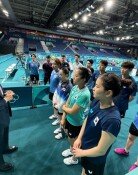Real GDP Growth in 1st Half Posts 10-year High
Real GDP Growth in 1st Half Posts 10-year High
Posted July. 27, 2010 13:29,
Real GDP growth in the second quarter this year reached 7.2 percent for first-half growth of 7.6 percent, the highest since 10.8 percent in the first half of 2000, the Bank of Korea said Monday.
Real GDP growth in the second quarter was 7.2 percent year-on-year and grew 1.5 percent from the first quarter, according to a report released by the central bank.
Kim Myung-kee, director-general of the central bank`s statistics department, said, The Korean economy has continued to post strong growth that has exceeded expectations, indicating a possible return to pre-crisis levels or even the start of expansion.
Continued strength of exports and consequent vitality in facility investment were particularly evident in the second quarter. Production in manufacturing grew 18 percent year-on-year thanks to the strong performance of export-driven industries such as machinery, metal and cars, and rose 5.1 percent from the previous quarter.
Second-quarter production in the service industry edged up 3.7 percent year-on-year and 0.2 percent from the first quarter. This was thanks to business recovery and rise in export and import volume in the wholesale, retail, restaurant, accommodation, transportation and storage sectors.
In contrast, production in construction decreased 0.5 percent year-on-year in the second quarter, its first fall since a drop of 6.8 percent in the fourth quarter of 2008.
The private sectors contribution to growth of domestic demand also rose in the second quarter. The Korean economy maintains an export-driven structure but has also benefited from strong domestic investment and consumption as well as brisk exports since the end of last year.
Spending on consumables dropped but that for services rose, raising private consumption 0.8 percent from the first quarter. Facility investment rose 8.1 percent from the first quarter thanks to expanded machinery investment such as that for semiconductor manufacturing equipment.
The contribution of the private sector to domestic demand growth rose from 4.2 percentage points in the third quarter last year to 1.2 percentage points in the fourth quarter, 1.1 percentage points in the first quarter this year, and 2.2 percentage points in the second quarter.
Nevertheless, industries driving domestic demand and exports showed significant growth disparity. Director-general Kim said, Though export industries posted growth of 17.3 percent, domestic demand industries recorded only 4.3 percent in the second quarter.
Market speculation is rising over whether the central banks belief that the economy might be expanding again will hasten an additional rise in the benchmark interest rate. In the economic cycle, the expansionary phase requires policies to prevent overheating and excessive growth through higher interest rates when the economy is seen to be peaking.
Experts, however, say the second-quarter figures do not foreshadow an early hike in the benchmark interest rate since the results were expected and because of other indicators hinting at slower growth in the second half of this year.
Shin Dong-jun, head of investment strategy at Dongbu Securities, said, Figures indicating that the economy has gone past the rationalization point emerged at the end of last year, so the latest announcement wont significantly hasten another interest rate hike. In the three-percent range, the government should make stable decisions instead of being spontaneously swayed by momentary figures.
Yoo Byung-kyu, head of the economic research team at Hyundai Research Institute, said, Demand pressure could increase in the second half, but external conditions are unclear. Therefore, the timing of the next rise in the interest rate should be decided after careful consideration of domestic and external conditions.
achim@donga.com







